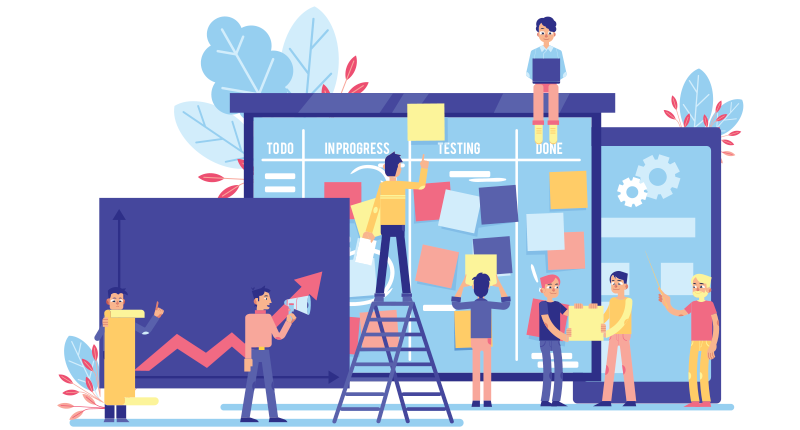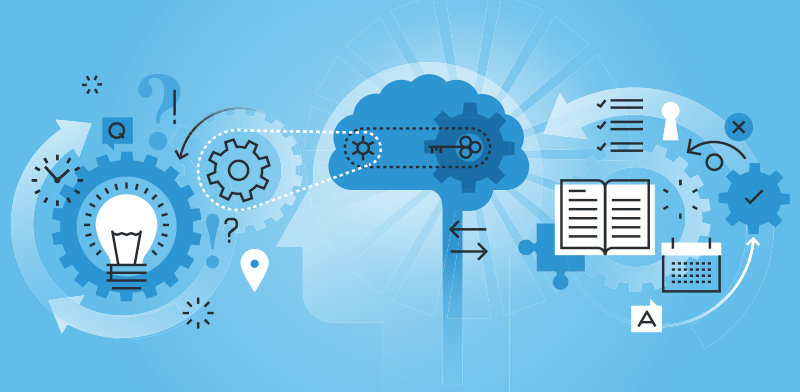
Digital Agency Blog
The Case for Adopting New Marketing Methodologies
The need for businesses to embrace digital transformation has never been clearer.
Transformational change occurs when new technology and consumer habits cause significant paradigm shifts. Examples of this type of change are common throughout history: for instance, consider the discovery of fire, the invention of written language, or the development of the Internet. FabCom believes that we are on the verge of another discontinuous innovation with the implementation of AI-enabled marketing. To understand why, it is helpful to examine the contexts that enabled previous sea changes.
Transformational Change in Marketing Communications
During previous transformational changes, consumers had significant adjustment periods to become acclimated to new technology. For examples from history, we can look at the invention of writing or the printing press, both of which fundamentally changed communications.
Both of these examples are case studies of converging systems and technologies. Consider Sumerian cuneiform writing circa 3400 BC. It sprang from the convergence of traditional pictographs and abstract mathematics, as well as burgeoning social systems of religion and commerce. In this context, the invention of writing filled a need: these early writings were necessary for merchants to record sales, and for priests to enshrine religious doctrine.
Similarly, the Gutenberg printing press reimagined the use of previous inventions, like that of writing and machinery. This single innovation pushed Europe into the Age of Enlightenment and ushered in the Scientific Revolution. It’s important to note that rudimentary forms of printing extant in Asia predated Gutenberg’s invention. However, the Chinese block-printing method, developed around 700 CE, was unable to achieve the same level of success, likely due to the low levels of literacy. In other words, although the technology existed, there was no social pressure to encourage mass adoption.
Modern historians can point to another world-changing transformation: the advent of the Internet. In 1991, scientists harnessed the converging innovations in computing, networking, and telephony to launch the World Wide Web, which has fundamentally changed how the modern world communicates. The new Internet came with significant and well-publicized benefits which encouraged mass adoption. For instance, email was a far easier method of communication than faxing.
Modern communications professionals should note that the pace at which users adopted these innovations has rapidly increased as technology builds upon itself. Sumerian cuneiform writing was developed and spread around Mesopotamia over hundreds of years. The printing press took several decades until mass adoption happened throughout Europe. The Internet, on the other hand, took less than a decade until it was embraced by consumers.

AI & the Advent of Dynamic 1:1 Communications
In 2020, we are on the cusp of another communications revolution, and this one is anticipated to be even more impactful than those previous. As with previous sea changes, the upcoming change to an AI-driven world will upend the current status quo, especially in the area of marketing communications.
The traditional marketing methodology relies on a one-to-many communications approach. A single message is crafted and then sent to a large audience segment, in the hopes that this message will reach their audience in the right channel, place, and time to resonate with a percentage of that audience, who will then presumably move towards a conversion.
However, this methodology is rife with issues—chiefly, a lack of feedback on what’s working. Advertisers can point to impressions, clicks, and a raft of other KPIs that indicate a marketing initiative is successful—but can they quantify the value of branding in driving secondary conversions? The problem is the same as that articulated by legendary John Wanamaker over a century ago: “Half the money I spend on advertising is wasted; the trouble is I don’t know which half.”
Practitioners of the craft may appreciate that this ambiguity was not the fault of marketers; they were limited by the technology they had available. For instance, to keep marketing initiatives manageable, advertisers have traditionally focused only on their largest customer segments. This allowed them to craft a message that highlighted a particular aspect of their brand, and which resonated with a fraction of that audience that found that aspect compelling. Unfortunately, this meant that this communication was irrelevant to the majority of the audience. Clearly, this is not the most efficient means of communicating with prospective customers.
However, as machine learning has improved, the capabilities of marketers has skyrocketed. Once they are no longer bound by the limitations of one-to-many communications, marketing professionals can craft highly relevant, personalized message to their audience segments to increase the chances of conversion. Additionally, AI-enabled workflows allow for dynamic marketing across channels, which drives further performance increases.

Brand Mapping: The Most Efficient Way to Communicate
FabCom has been pioneering the one-to-one approach to marketing for the last decade, and their experience has allowed them to implement this approach with efficiency and scalability.
In the AI-enabled paradigm, marketers have the ability to segment their audience with precision. Rather than relying solely on the largest segment of an audience to increase market share, brands can now target multiple segments and more discrete audiences with individualized messaging. Savvy marketers can identify multiple brands attributes and highlight those attributes in messaging to a smaller audience chosen for their connection to these attributes. Consequently, these disparate audiences statistically find these communications to be more compelling as they are personalized to that audiences’ needs and values.
AI-supported marketing can also play a pivotal role in determining when a message should be sent. Rather than relying on a static window of opportunity, AI systems can dynamically send out personalized messages based on pre-established triggers. For instance, if an online customer is shopping but closes their browser without purchasing, an email can be automatically sent reminding them to complete the purchase, and possibly suggest complimentary products. Reaching customers during this critical window when they are most likely to take a desired action is crucial to drive increases in market share, while simultaneously providing a superior customer experience.
Converging Technologies & Audience Expectations: The Perfect Storm
Unlike with previous transformational changes, FabCom anticipates that the transition to AI will be much quicker. The exponential growth of computing power has led to ever-increasing machine-learning capabilities, of which the public is aware. This awareness generates expectation, which will only grow as first-adopter brands capitalize on AI capabilities to deliver superior customer experiences.
Audience expectations are also raised by the ubiquity of social media. Users are no longer content to passively receive communications from brands; instead, they demand a dialogic approach. While it’s possible for a human-only marketing team to deliver a dialogic marketing approach, the inefficiencies in cost make this inviable for most brands, despite the benefits.
The convergence of improving technologies and audience expectations will make strategic, AI-enabled marketing a necessity for organizations looking to grow. This trend has been compounded by the 2020 COVID-19 pandemic, as homebound audiences began demanding more from their online experiences.

Cost of Adopting AI: Barrier of Entry, or Bridge of Opportunity?
Developing new systems and processes to utilize an AI-enabled marketing workflow can be costly and time-consuming. Brands attempting to adopt this methodology may invest a lot of capital and many years acquiring the diversity of expertise and technology necessary to implement an efficient workflow that can generate positive ROI.
However, an integrated marketing agency with experience in this methodology can bypass these inefficiencies. After all, this kind of new breed marketing agency has spent time accumulating the necessary talent and expertise, and will avoid the mistakes made by AI neophytes.
In fact, considering the delta in ROI between an integrated marketing agency with experience in AI-enabled workflows and an inexperienced in-house marketing team, a strong argument can be made that it’s more fiscally efficient to hire an agency to develop a customized AI-enabled workflow.
Historically, brands that are early adopters of new business technologies have gained significant market share as consumers flock to reap the associated benefits. As social habits solidify around the new technology, brands who have invested in this innovation and continue to deliver a superior customer experience will retain this increased market share in the years following.
Additionally, while the upfront costs of an integrated marketing and advertising agency may outstrip that of a fledgling in-house marketing team, the ROI generated by such an agency can outweigh the expense. For an example, FabCom points to results from a marketing split-test that showed a 220 percent increase in conversions when comparing the performance against that of an in-house team on the same campaign. Similarly, in a case study involving a prestigious university, FabCom was able to achieve 118 percent increase in responses. In both situations, performance was driven by 1:1 marketing tactics, like personalized URLS (PURLs), dynamic direct-marketing, and personalized messages. This kind of ROI makes a compelling case for agency adoption.
Conclusion: The Inevitability of AI-Enabled Marketing
As technologies and social habits converge, transformational change is inevitable. Throughout history, we have seen this pattern repeat. As technology rapidly advances, the rate of mass adoption of transformational technologies also speeds up. It’s clear that the conditions for major transformational change are already present in modern society—the convergent technologies, societal appetite, and profit motives have all combined to provide a once-in-a-lifetime opportunity for marketers to transform the customer experience. Brands that capitalize on this opportunity will be rewarded with increased market share, brand perception, and superior customer advocacy due to improved customer experience. Brands that opt to wait on adopting AI-enabled workflows may be left with obsolete methodologies that will require significant resources to catch up, or resign themselves to being left behind.

AI Marketing Experts
FabCom has been deploying dynamic messaging driven by strategy, design, and technology since the 1990s, when they first began using machine learning and AI-driven marketing funnels to deploy their tribal knowledge with efficiency and scalability.
As the first marketing and advertising agency in the Southwest to jump on board with the full suite of IBM Cognos and Watson business analytic tools, FabCom is now an established leader in AI-integrated marketing worldwide. By deploying AI technology to create brand-centric customer experiences, smarter marketing campaigns, and timely marketing business intelligence, they have been creating unprecedented ROI for their clients. Even better, they are able to leverage their expertise to create a customized solution that performs better, is ready faster, and costs less than a similar initiative created by a less-experienced in-house team.